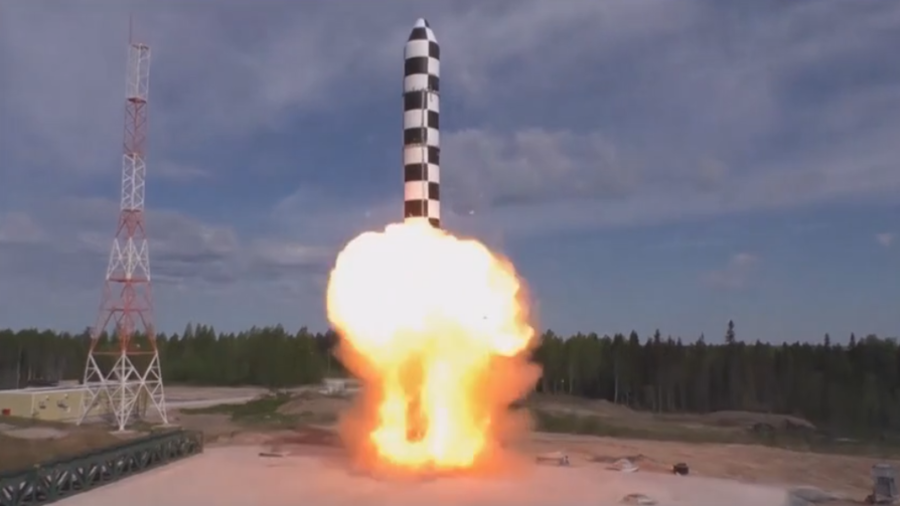Fresh footage of futuristic weapon tests & development released by Russian military (VIDEOS)

Russia's Defense Ministry has released a new batch of videos of cutting-edge weapons, first unveiled by President Vladimir Putin back in March. The footage shows new tests, as well as gives a grasp of the development process.
The impressive set of new weapons was unveiled by Putin during his annual speech before the Federation Council back in March. The futuristic armaments, some of which are already in service, are designed to give Russia a strong deterrence against any aggression against the country.
High-precision hypersonic weaponry
The hypersonic air-launched Kinzhal missile, which is able to travel 10 times faster than the speed of sound, continues to undergo tests in the Southern Military District. The aviation unit that received the new missiles last December has flown over 350 missions with Kinzhals attached and launched it a number of times. The missile is launched from a high-altitude MiG-31 fighter jet, and it has an effective range of 2,000 kilometers. The Kinzhal can be fitted with nuclear and conventional warheads, and it is able to penetrate the most elaborate air defenses.
Another hypersonic novelty, the Avangard missile complex, has finally entered production, Deputy Commander of the Strategic Missile Forces Major General Sergey Poroskun has said. While the new weapon is still being tested, the existing military infrastructure – presumably underground silos – is being tweaked to accommodate the device, he added.
The new video shows the Avangard glider, fitted to a ballistic missile, being loaded into an underground silo. It sheds little light on the actual performance of the system, since the actual footage is followed by the same animation first shown to the public back in March. The device is advertised as capable of traveling at hypersonic speeds and withstanding extremely high temperatures during the final approach to its target. The system is said to retain maneuverability and can be controlled until the very moment it hits a target.
New-generation Sarmat ICBM
The newest Russian liquid-propelled intercontinental ballistic missile (ICBM), the RS-28 Sarmat (NATO reporting name SS-X-30 Satan-2) is set to replace the aging R-36 M2 Voevoda missile (NATO reporting name Satan). The Sarmat is designed to be able to carry any existing type of warhead and has virtually no range limit, delivering its payload anywhere on the planet across either the South or the North Pole. The missile has successfully passed the launch tests and now is readied for flight testing, the Defense Ministry has said.
The video demonstrates the missile in a transport container, as well as its loading into an underground silo, and briefly shows the moment when the bright checkered-coated missile leaves the silo. It also gives a sneak peek into the development process, showing fairings, engines and other parts of the missile in a military research facility.
Nuclear-powered weapons fleshing out
While the nuclear propulsion system for the cruise missile, dubbed 'Burevestnik' has been already successfully tested, its frame still needs some tweaking. As for now, the various components of the missile are receiving necessary improvements, one of the developers, Sergey Pertsev, has said. The missile, which is designed to have "unlimited range and unlimited ability to maneuver," undergoes additional ground tests and is expected to get into flight tests following the tweaks.
The new video on the 'Burevestnik' cruise missile, therefore, focuses entirely on the research and development process. It features several missiles in a workshop, some of them already placed into launch containers.
The "sister" project of 'Burevestnik', the 'Poseidon' drone submarine, which boasts the miniature nuclear propulsion system as well, is also shaping up. The new video shows a static test of the sub, which is basically an enormous nuclear-capable torpedo. Rudders of the large device and its propeller are moving while developers observe its performance. The most intriguing part of the drone submarine – its propeller – is blurred out.
The device is launched from a crewed submarine and travels to its target at high speeds deep underwater, which makes it nearly impossible to intercept, according to the Russian military.
"Unique characteristics of the 'Poseidon' system will help the Navy to successfully combat aircraft carrier and strike groups of a potential adversary in any oceanic theater of war and destroy shore infrastructure facilities," chief analyst of the General Staff, Admiral Igor Kasatonov, has said.
Combat laser system remains a mystery
The "combat laser system" Putin announced back in March gets to keep its title of the most mysterious one, since the new video again sheds little light on what exactly it's supposed to do.
The video features a military unit, operating at least two truck-mounted Peresvet systems, accompanied by several command and support vehicles. When deployed, the complex unfolds and exposes a cannon-like device, which is presumably the laser system.
The exact purpose of the complex is still kept secret. It might be a jamming system, which can "blind" the optical electronic equipment of enemy vehicles with a laser beam, since several prototypes of such systems have been developed by the Soviet Union.
Several projects of anti-aircraft and anti-satellite laser systems have also existed, yet none of them materialized. The "combat laser system" designation, however, does give off the sci-fi vibe of a futuristic device capable of burning holes in armor.
Subscribe to RT newsletter to get stories the mainstream media won’t tell you.
Like this story? Share it with a friend!















